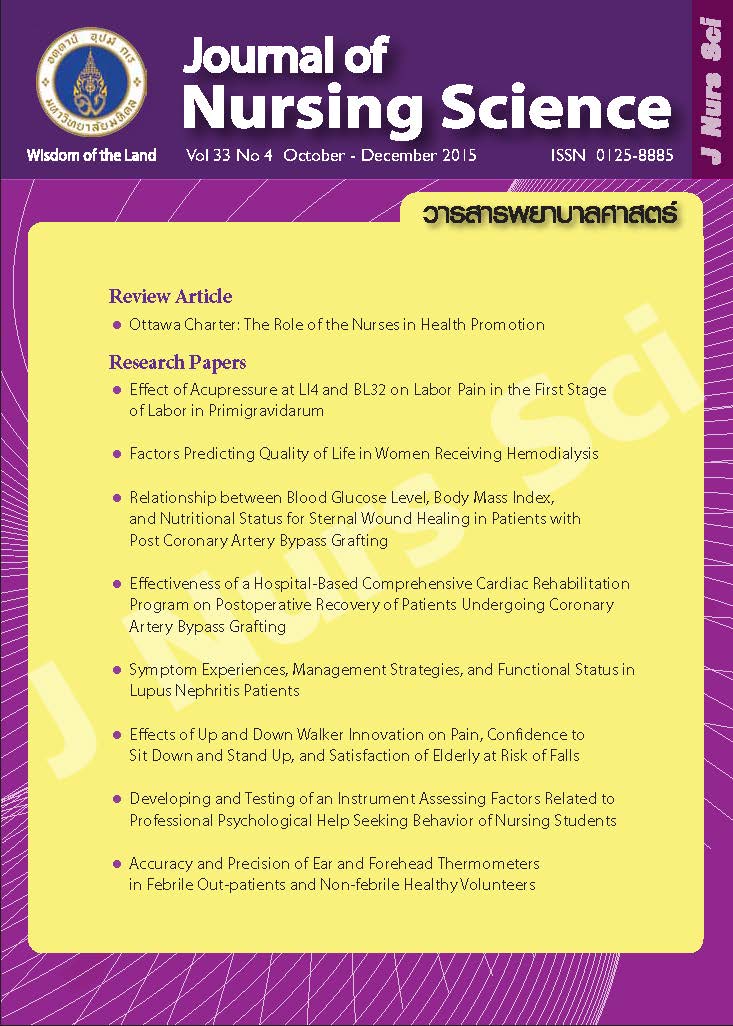Symptom Experiences, Management Strategies, and Functional Status in Lupus Nephritis Patients
Main Article Content
Abstract
Purpose: To explore the symptom experiences, management strategies, functional status in lupus nephritis and the relationships between symptom experiences and functional status in lupus nephritis patients.
Design: A descriptive correlation study design.
Methods: The sample consisted of 100 lupus nephritis patients who were 18 years or older. Data were collected using questionnaires on demographic characteristics, the Memorial Symptom Assessment Scale, management strategies, and the Thai-Modified function Living Index Cancer.
Main findings: The patients had a good functional status (mean = 47.74, SD = 7.79). Blurred vision, insomnia, fatigue, and headache were significantly negative correlated with functional status. (r = - .32, - .31, - .49, - .49, - .23, respectively; p < .05) The most common symptom management strategies by patients to manage the top five common symptoms (headache, sleeping difficulties, fatigue, arthralgia, and vision loss) were taking medication, trying sleep, rest, and seeing a doctor.
Conclusions and recommendations: Nurses should evaluate symptoms and plan effective care as well as provide knowledge to patients and families. Moreover, nurses should conduct research and develop program to retrieve symptoms and enrich functional status of Lupus Nephritis Patients.
ประสบการณ์การมีอาการ กลวิธีการจัดการอาการ และภาวะการทำหน้าที่ในผู้ป่วยไตอักเสบลูปัส
บทคัดย่อ
วัตถุประสงค์: เพื่อศึกษาประสบการณ์การมีอาการ กลวิธีการจัดการอาการ และภาวะการทำหน้าที่ และศึกษาความสัมพันธ์ระหว่างประสบการณ์การมีอาการและภาวะการทำหน้าที่ในผู้ป่วยไตอักเสบลูปัส
รูปแบบการวิจัย: การวิจัยเชิงบรรยายวิเคราะห์ความสัมพันธ์
วิธีดำเนินการวิจัย: กลุ่มตัวอย่างเป็นผู้ป่วยโรคไตอักเสบลูปัสจำนวน 100 คนซึ่งมีอายุตั้งแต่ 18 ปีขึ้นไปเครื่องมือที่ใช้ในการเก็บข้อมูล ได้แก่ แบบบันทึกข้อมูลทั่วไป แบบสอบถามประสบการณ์การมีอาการของผู้ป่วยไตอักเสบลูปัส แบบสัมภาษณ์กลวิธีการจัดการอาการ และแบบสอบถามภาวะการทำหน้าที่
ผลการวิจัย: กลุ่มตัวอย่างมีคะแนนเฉลี่ยของภาวะการทำหน้าที่อยู่ในเกณฑ์ดี (Mean = 47.74 SD = 7.79) ประสบการณ์การมีอาการที่รบกวนการดำเนินชีวิตมากที่สุด 5 อันดับแรก ได้แก่ ตามัว นอนไม่หลับ อ่อนเพลีย/ไม่มีแรง ปวดข้อ และปวดศีรษะ มีค่าความสัมพันธ์เชิงลบกับภาวะการทำหน้าที่ อย่างมีนัยสำคัญทางสถิติ (r= - .32, - .31, - .49, - .49, - .23 ตามลำดับ; p < .05) กลุ่มตัวอย่างจัดการกับอาการปวดศีรษะ นอนไม่หลับ/นอนยาก อ่อนเพลีย/ไม่มีแรง ปวดข้อ และตามัว โดยกลวิธีการจัดการอาการใช้การรับประทานยาแก้ปวดการพยายามฝืนนอนหลับ การนอนพัก การทายาลดปวด/เมื่อย การไปพบแพทย์ ตามลำดับ
สรุปและข้อเสนอแนะ: พยาบาลควรประเมินอาการ และวางแผนการดูแลที่มีประสิทธิภาพ และให้ความรู้แก่ผู้ป่วยและครอบครัว นอกจากนี้พยาบาลควรมีการทำวิจัย และพัฒนาโปรแกรมการจัดการอาการที่มีประสิทธิภาพเพื่อลดความทุกข์ทรมานจากอาการต่างๆ และเพิ่มภาวะการทำหน้าที่ที่ดีขึ้นของผู้ป่วยไตอักเสบลูปัส
คำสำคัญ: ไตอักเสบลูปัส ประสบการณ์การมีอาการ กลวิธีการจัดการอาการ ภาวะการทำหน้าที่
Article Details
Copyright Notice: Nursing Science Journal of Thailand has exclusive rights to publish and distribute the manuscript and all contents therein. Without the journal’s permission, the dissemination of the manuscript in another journal or online, and the reproduction of the manuscript for non-educational purpose are prohibited.

Disclaimer: The opinion expressed and figures provided in this journal, NSJT, are the sole responsibility of the authors. The editorial board bears no responsibility in this regard.


